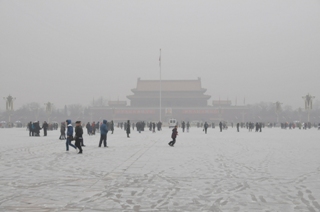Sep 18 2014
At the beginning of 2013 a greyish-brown blanket of smog lay over large areas of China for several months. The fine particle pollution was higher by 1 to 2 orders of magnitude than the levels normally measured in Western Europe and the United States.
 Images of the „airpocalypse“, here on Tiananmen Square in Beijing. In the Chinese capital, coal combustion was the main source of the record high particulate air pollution. Picture: Paul Scherrer Institute.
Images of the „airpocalypse“, here on Tiananmen Square in Beijing. In the Chinese capital, coal combustion was the main source of the record high particulate air pollution. Picture: Paul Scherrer Institute.
An international team of researchers under the lead of the Paul Scherrer Institute PSI and the Institute of Earth Environment, Chinese Academy of the Sciences revealed the causes of the “airpocalypse”. The study published in the journal Nature also describes what steps are to be taken to prevent an environmental crisis of this kind in the future.
In the social media Chinese people quickly came up with dramatic names for this really serious phenomenon which started at the beginning of 2013 and lasted several months. Names like “airpocalypse” and “airmaggedon” reflected the major concerns of many people about the drastic deterioration in air quality in cities like Beijing, Shanghai, Guangzhou and Xi’an. The Chinese government ordered the temporary closure of schools and called on people to stay indoors. Building sites were sprayed with water to wash off dust. The number of registered patients with acute respiratory disorders increased at breakneck speed. The government was swift to act: in an ambitious plan of action to prevent and monitor air pollution it set itself the goal of reducing fine particle pollution by up to 25 percent by 2017 compared with the 2012 levels.
Major gaps in knowledge about fine particle sources
Effective medium-term and long-term measures to reduce pollution caused by fine particle are hampered by one basic shortcoming in China: a lack of knowledge about where the fine dust comes from. International co-operation under the lead of the researchers from the PSI Laboratory of Atmospheric Chemistry and CAS Institute of Earth Environment has now presented a study which is unique in terms of the scale of detail in China. It identifies the sources and chemical composition of fine particles (PM2.5) during the record level pollution period. The authors outline what fine particle reduction measures would be beneficial in the future.
Indirect emissions are dominant
André Prévôt from the Paul Scherrer Institute formulates the most important finding as follows, “If we want to prevent a repeat of 'airmaggedon' then we have to focus more on emissions which indirectly lead to fine particle formation. During the period concerned between half and three-quarters of the fine particle mass in the cities Beijing, Shanghai and Guangzhou was not, in fact, emitted directly as fine particles but formed in the air from gaseous precursors.” In contrast to, for example, soot these trace gases are chemically converted in the atmosphere into fine particle mass. The main fine particle precursors include sulphur dioxide (mainly from fossil fuel combustion), nitrogen oxide (from traffic and power plants), ammonia, and what are known as volatile organic compounds - VOCs (from e.g. the combustion of coal, biomass or fuels in combustion engines). Only in the western Chinese city of Xi’an did the researchers observe a dominant role of direct fine dust emissions which probably come for the most part from the neighbouring desert regions – although the brisk construction work and traffic in the city probably contributed appreciable amounts that shouldn’t be underestimated. Still, even in Xi’an the secondary fine particle mass accounted for 30 percent of the particle pollution.
Colourful regional pattern of sources
The measurements and their statistical analyses confirm that coal combustion in the north (Beijing) and in the west (Xi’an) is very important when it comes to direct emissions. Coal heating within a radius of 1,000 kilometres of these cities is very widespread. Coal combustion releases large amounts of what are known as polycyclic aromatic hydrocarbons (PAHs) and heavy metals like arsenic and lead – pollutants that can have a harmful effect on the cardiovascular system and the respiratory tract. Moreover, in Xi’an the hesitant enforcement of emission provisions for motor vehicles was noticeable. There road traffic pollutes the air far more with fine dust than in other cities although the volume of traffic is much lower in Xi’an. Furthermore, biomass combustion is widespread in winter, particularly from wood and crop residual burning. It contributes similar relative shares in the various cities. For all fine particle sources, transport of air masses from the surrounding region should likewise be considered, particularly in large urban agglomerations. Also in cities fine particle pollution is only partially a “homemade” problem.
Source: http://www.psi.ch/